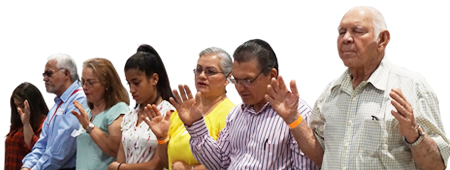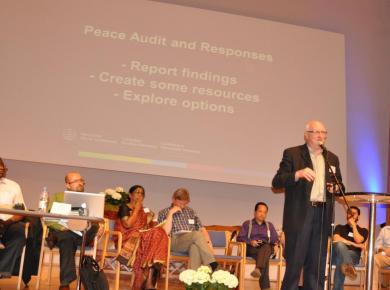Posted: May 19, 2016
We estimate that there are 9,500 congregations throughout the world that are part of the Mennonite World Conference (MWC) family. These congregations are found in every continent and in every imaginable context. This means that there are, potentially, thousands of active communities of the peace of Christ functioning in many contexts in need of reconciliation. The vision of the MWC Peace Commission is to encourage, nourish and resource these agents of peace.
With this vision in mind, we wanted to hear from the member-churches of MWC. We asked them to answer a simple question: “How is your church doing in its desire to be a Peace Church?”
What did we learn? It was encouraging and very moving to read the responses. They were vulnerable and provided profound and intimate windows into the lives of MWC member-churches. They put us in touch with the challenges faced and the efforts engaged by the churches in their desire to be effective ambassadors of peace in our broken world. Here’s what we learned:
1. All respondents expressed a deep desire to be a “Peace Church.” They understood that as being communities of Jesus’ disciples and actively nonviolent in their contexts.
2. All respondents talked about important and creative ways that they are working at strengthening their identity as Peace Churches.
3. Most respondents pointed to important “official” statements that identified them as churches with a Peace Church vision.
4. All respondents indicated that there is a gap (some wider than others) that separates the official statements of the church from the life of the church and congregations.
5. All respondents identified important and daunting challenges they face in their efforts at being a Peace Church.
6. Respondents indicated that the understanding of peace is shifting from reaction (do no harm to others) to action (do good for others).
7. All respondents said that they need more resources and resourcing to strengthen their identity as Peace Churches.
What are the challenges? The most moving parts of the responses were those that talked about their contextual challenges to being a Peace Church. (To read the full report, visit www. mwc-cmm.org/article/peace-commission) It is clear that our vision for 9,500 effective communal peace ambassadors at work in each context is a very high calling. Two things are very evident: the peace vocation is extremely important and necessary, and pursuing that vocation is exceptionally complex.
Space does not permit me to delve into all the details. But let me give a taste of the challenges that we face:
From Canada: The numbing impact of individualistic materialism, affluence and comfort shield us from the broken worlds of poverty, revolution and violence.
From Honduras: The continuing influence of machoism in gender and social relationships eclipses the peace of Christ.
From Taiwan: The militarized atmosphere generated by thousands of Chinese missiles aimed at every part of Taiwan makes it difficult to love our enemies as Christ commanded.
From Indonesia: We stumble in forming a peace-church identity because the pastors of our churches graduate from seminaries that do not teach peace.
From Spain: We share a “basket of love” with each other, but we need to do much more.
Any one of these challenges is formidable enough. When all are put together, we can see the enormity of our vocation. Peace is badly needed in our world, but practicing it is complex. Perhaps the clearest lesson we can learn from the responses is that we will not be “unpremeditated” Peace Churches. We’ll need to work at it – intentionally, overtly, and strategically.
A pressing question I remember a visit we had with the leaders of a semi-rural congregation in central India. They told us that their children and grand- children no longer know what it means to be “Mennonite.” They were sad about this, and asked: “What is MWC going to do about that?”
The question from India is profound. It identifies a preferred theological identity. It also says that this identity must be accompanied by congregational and church behaviours that deliberately stimulate and strengthen this identity.
What is MWC doing about it? MWC is responding in several ways. First, we are continuing to promote our “Shared Convictions,” prepared by MWC in 2006. They provide a common foundation for our desire to be an Anabaptist Peace Church. They are there to be studied, shared and used.
Second, MWC has approved a number of resources for member-churches looking to strengthen their Anabaptist-Mennonite identity. Books like Alfred Neufeld’s What We Believe Together, Paulus Widijaia’s and Alan and Eleanor Kreider’s A Culture of Peace and C. Arnold Snyder’s From Anabaptist Seed, are all good resources on Anabaptist identity from a variety of angles (historical, theological, etc.). (For a complete list of books, visit www. mwc-cmm.org/article/books) The final reports from the Mennonite- Lutheran and Mennonite-Catholic international dialogues are very helpful documents that could be adapted to the teaching ministry of the church. And the three papers recently discussed and approved by the MWC General Council are another instructive and useful set of resources. (To read the papers, visit www. mwc-cmm.org/article/faith-andlife- commission)
Third, the MWC Faith and Life Commission plans to offer “identity workshops” to churches requesting such resourcing. The Commission hopes that these seminars can be face-to-face, dynamic and stimulating, as questions of Anabaptist identity are explored together with key resource teachers.
Fourth, MWC plans to place regional representatives in each continent. Such individuals can encourage member-churches in that region to work together at the peace-related questions and challenges.
Fifth, the MWC Peace Commission has designed an attractive “Peace Poster” that will helpfully remind us of the centrality of peace in the gospel of Christ. (The poster is included as an insert in this issue of the magazine.) We hope that this visual resource can find a prominent place in the worship spaces of MWC congregations. Additionally, the Peace Commission is working to produce some guidelines for conflict assessment and management.
Finally, and perhaps most importantly, MWC provides an opportunity and a real-life structure that enables member-churches from all over the world to say, “We belong together.” Someone will surely ask: What do you belong to? Why do you belong? Why is it important to belong? These questions are excellent opportunities to clarify our identity and vocation as a Peace Church.
-Robert J. Suderman is Secretary of the MWC Peace Commission.
PEACE POSTER
Click here to see the peace poster. This poster, developed by the MWC Peace Commission and designed by Glenn Fretz, is intended to remind MWC member-churches of the centrality of peace in the gospel of Christ.
SIDEBAR
Who Responded to the Peace Audit?
When the MWC Peace Commission asked, “How is your church doing in its desire to be a Peace Church?”, 21 (out of 100) member-churches from four continents responded.
The participants were:


Join the Conversation on Social Media
FacebookTwitterInstagramFlickrYouTube